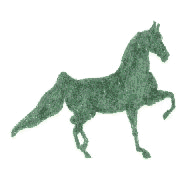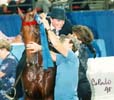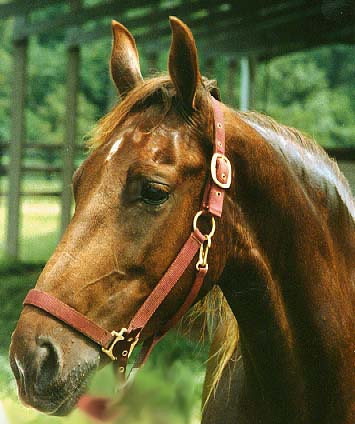 Welcome to the Horsin'
Around Page!
Welcome to the Horsin'
Around Page! Welcome to the Horsin'
Around Page!
Welcome to the Horsin'
Around Page! Here are Tom and Laura at the World Championship Horse Show at the Kentucky State Fair. They won the 1998 World Championship Jr. Exhibitor Class. Woohoo!
Here are Tom and Laura at the World Championship Horse Show at the Kentucky State Fair. They won the 1998 World Championship Jr. Exhibitor Class. Woohoo!
Here is a picture of Certainly a Star (aka "Tom"): 
And this is Attadoll:  She was the first horse we owned, and
she's the horse both Laura and I learned to ride on. Sadly, Attadoll crossed over the Rainbow Bridge last March. She is sorely missed by all of us.
She was the first horse we owned, and
she's the horse both Laura and I learned to ride on. Sadly, Attadoll crossed over the Rainbow Bridge last March. She is sorely missed by all of us.
Most of our summers are spent traveling the horse show circuit. It's a lot of work, but lots of fun. The music that is playing now is a song often played while the horses go through their gaits-- usually the trot, followed by the slow gait, rack, and canter.

The American Saddlebred horse has been hailed by a host of admirers as the world's most beautiful horse and also one of the most versatile. It was developed in colonial America by horse breeders seeking a utility horse of beauty, easy gaits, good disposition, intelligence, substance, and endurance.
The ancestors of the Saddlebred were easy-gaited Galloways and Hobbies. Brought to North America from the British Isles and bred selectively, they evolved into Naragansett Pacers, which were crossed with Thoroughbred imports, resulting in the early Saddlebreds, known then as "Saddle Horses" or "Kentucky Saddlers."
The epitome of a show horse, the Saddlebred has a carriage and attitude elusive of description--some call it class, presence, quality, style or charm. A superior air distinguishes every movement.
The ideal Saddlebred is well-proportioned, with a well-shaped, finely chiseled head and large expressive eyes. The back should be short and level, the legs clean and straight, with long, sloping pasterns and well-formed feet. Masculinity in stallions and femininity in mares are important. The average height is from 15-16 hands, and the weight 1,000 to 1,200 pounds. Any color is acceptable. The most prominent are: chestnut, bay, brown and black, with some gray, roan, golden and pinto(spotted).
The five-gaited classes (which is what Laura showed with Tara and Tom, above) are considered by many as the most spectacular and exciting in the show because of the speed and strength exhibited by these well-trained equine athletes. Five-gaited horses have long, flowing manes and tails and show both ways of the ring at the walk, trot, canter, slow gait and rack. The slow gait and rack are lateral four-beat gaits inherited by Saddlebreds from ancient English ancestors and are comfortable riding gaits. Protective boots are worn on the front feet to prevent possible injury from the hind feet when the horse is traveling fast.
The trot is a square, bold, two-beat gait performed with speed, form, and natural, high action. The canter is slow, rhythmic, and must be executed on the correct lead (left forefoot leading in the counterclockwise direction; right forefoot leading in the clockwise direction). The slow gait is a high action gait, performed slowly, while the rack is fast, showing action, energy and power. The walk is springy and athletic. The best performer maintains good form and balance, even at speed.
I hope this bit of information is of interest to you. We love these horses, and if you ever get a chance to attend a show of this type, please do. I really think you'll enjoy it!

 Ya'll come back!!
Ya'll come back!!


I Am A Proud Member
Of:

Phenomenal Women Of The
Web
 Get your own FREE
homepage!!
Get your own FREE
homepage!!